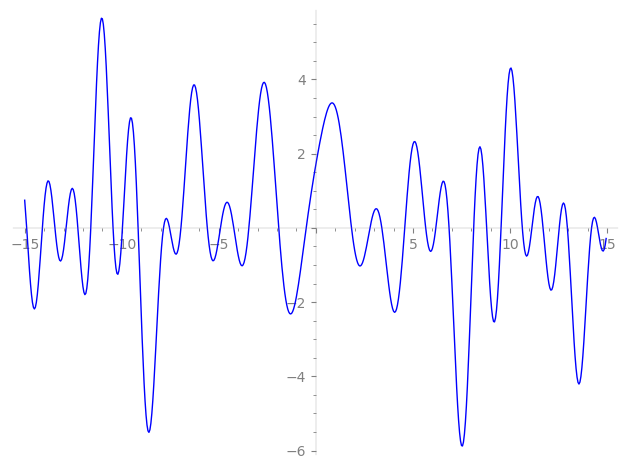| L(s) = 1 | + (0.866 + 0.5i)2-s + (0.499 + 0.866i)4-s + (−0.358 − 2.20i)5-s − 4.46i·7-s + 0.999i·8-s + (0.792 − 2.09i)10-s + 4.90i·11-s + (−2.12 − 3.67i)13-s + (2.23 − 3.86i)14-s + (−0.5 + 0.866i)16-s + (3.15 − 5.46i)17-s + (−3.5 + 2.59i)19-s + (1.73 − 1.41i)20-s + (−2.45 + 4.24i)22-s + (2.29 + 3.96i)23-s + ⋯ |
| L(s) = 1 | + (0.612 + 0.353i)2-s + (0.249 + 0.433i)4-s + (−0.160 − 0.987i)5-s − 1.68i·7-s + 0.353i·8-s + (0.250 − 0.661i)10-s + 1.47i·11-s + (−0.588 − 1.01i)13-s + (0.596 − 1.03i)14-s + (−0.125 + 0.216i)16-s + (0.765 − 1.32i)17-s + (−0.802 + 0.596i)19-s + (0.387 − 0.316i)20-s + (−0.522 + 0.905i)22-s + (0.477 + 0.827i)23-s + ⋯ |
Λ(s)=(=(1710s/2ΓC(s)L(s)(−0.239+0.970i)Λ(2−s)
Λ(s)=(=(1710s/2ΓC(s+1/2)L(s)(−0.239+0.970i)Λ(1−s)
| Degree: |
2 |
| Conductor: |
1710
= 2⋅32⋅5⋅19
|
| Sign: |
−0.239+0.970i
|
| Analytic conductor: |
13.6544 |
| Root analytic conductor: |
3.69518 |
| Motivic weight: |
1 |
| Rational: |
no |
| Arithmetic: |
yes |
| Character: |
χ1710(179,⋅)
|
| Primitive: |
yes
|
| Self-dual: |
no
|
| Analytic rank: |
0
|
| Selberg data: |
(2, 1710, ( :1/2), −0.239+0.970i)
|
Particular Values
| L(1) |
≈ |
1.717542576 |
| L(21) |
≈ |
1.717542576 |
| L(23) |
|
not available |
| L(1) |
|
not available |
L(s)=p∏Fp(p−s)−1 | p | Fp(T) |
|---|
| bad | 2 | 1+(−0.866−0.5i)T |
| 3 | 1 |
| 5 | 1+(0.358+2.20i)T |
| 19 | 1+(3.5−2.59i)T |
| good | 7 | 1+4.46iT−7T2 |
| 11 | 1−4.90iT−11T2 |
| 13 | 1+(2.12+3.67i)T+(−6.5+11.2i)T2 |
| 17 | 1+(−3.15+5.46i)T+(−8.5−14.7i)T2 |
| 23 | 1+(−2.29−3.96i)T+(−11.5+19.9i)T2 |
| 29 | 1+(3.67+6.36i)T+(−14.5+25.1i)T2 |
| 31 | 1−31T2 |
| 37 | 1+7.73T+37T2 |
| 41 | 1+(−5.47+9.47i)T+(−20.5−35.5i)T2 |
| 43 | 1+(−3.49−2.01i)T+(21.5+37.2i)T2 |
| 47 | 1+(6.31+10.9i)T+(−23.5+40.7i)T2 |
| 53 | 1+(1.67−0.968i)T+(26.5−45.8i)T2 |
| 59 | 1+(1.22−2.12i)T+(−29.5−51.0i)T2 |
| 61 | 1+(−0.468−0.811i)T+(−30.5+52.8i)T2 |
| 67 | 1+(−2.12−3.67i)T+(−33.5+58.0i)T2 |
| 71 | 1+(−3.67+6.36i)T+(−35.5−61.4i)T2 |
| 73 | 1+(9.85+5.68i)T+(36.5+63.2i)T2 |
| 79 | 1+(6+3.46i)T+(39.5+68.4i)T2 |
| 83 | 1−10.3T+83T2 |
| 89 | 1+(−3.02−5.23i)T+(−44.5+77.0i)T2 |
| 97 | 1+(−2.12+3.67i)T+(−48.5−84.0i)T2 |
| show more | |
| show less | |
L(s)=p∏ j=1∏2(1−αj,pp−s)−1
Imaginary part of the first few zeros on the critical line
−9.158242239340189258174830417939, −7.84924294540187504842415855036, −7.53891606311831704548987599331, −6.95211413804308443187585333959, −5.59350174467623055334454075165, −4.91694543067001279356239027888, −4.23116228828489532099135500136, −3.45265204625980133318700915664, −1.91580711248395424659105535561, −0.49969077604160881505230895068,
1.83361191679254322888254272162, 2.78579657623476819262387940381, 3.39579367804926990075149723753, 4.57626451741849583860056808917, 5.65536387709258928060330576257, 6.17790656998897392553629273357, 6.85867315007927667600771885071, 8.125784099098772298874918308143, 8.794840562043305212356550810999, 9.537622039837620271251480622392

